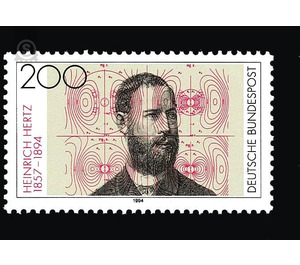100th anniversary of death of Heinrich Hertz - Germany / Federal Republic of Germany 1994 - 200 Pfennig
Theme: Calender
| Country | Germany / Federal Republic of Germany |
| Issue Date | 1994 |
| Face Value | 200.00 |
| Color | brown grey |
| Perforation | K 13:12 1/2 |
| Printing Type | Multicolor offset printing |
| Stamp Type | Postage stamp |
| Item Type | Stamp |
| Chronological Issue Number | 1583 |
| Chronological Chapter | GER-BRD |
| SID | 52936 |
| In 32 Wishlists | |
Heinrich Rudolf Hertz was born on February 22, 1857 in Hamburg as the eldest son of the former lawyer and later Justice Senator Gustav Ferdinand Hertz. After attending a private citizen school, private lessons and final schooling, he made his A-levels at the Johanneum in Hamburg in 1875 and then went to Frankfurt am Main to prepare as an intern for the engineering studies in Dresden, which began in April 1876. From the autumn of 1876 he completed a one-year officer training at the Berlin Rail Regiment and then continued his studies in Munich, where he finally made the decision to devote himself only to the natural sciences. For the winter semester of 1878, Heinrich Hertz moved to the University of Berlin and studied there u. a. at the physicist and physiologist Hermann von Helmholtz, who recognized and promoted his unusual talent and whose assistant he became in 1880 after graduation. In 1883, Hertz habilitated at the University of Kiel, where he received a teaching assignment for theoretical physics, before he was appointed in April 1885 to the chair of experimental physics at the Technical University of Karlsruhe. In early 1889 he accepted a call to the University of Bonn, where he succumbed to blood poisoning a few weeks before his 37th birthday, on 1 January 1894. Despite his relatively short life, Heinrich Hertz has left behind an extensive scientific work whose significance for the understanding of electromagnetic phenomena and mechanics remains undisputed today. From antiquity to the seventeenth century, electricity and magnetism were conceptually indistinguishable. Only the London court physician William Gilbert opened the way for systematic (and initially separate) exploration of electricity and magnetism through their clear separation of the two phenomena groundbreaking experimental and theoretical work by Michael Faraday and James Clerk Maxwell became apparent. The famous theory of Maxwell contained the prediction of electromagnetic waves, which were experimentally proved by Heinrich Hertz, after extensive preliminary work in Berlin and Kiel, during his time in Karlsruhe. This proof, which included the interpretation of light as electromagnetic waves, forms the basis for the use of the entire electromagnetic spectrum in today's information technology, including optical communications. At the same time Hertz developed in his extensive theoretical work a still valid mathematical formulation of the Maxwell equations and the aesthetically very appealing field line images of the Hertzian dipole, a transmitter of electromagnetic waves. Until his early death, he systematically researched the formation and propagation of electromagnetic waves in theoretical and experimental work. The investigation of a disturbing effect in his experiments - the release of electrons from metals under illumination with ultraviolet light - was the groundbreaking work of Hertz on the photoelectric effect, which was later interpreted theoretically by Albert Einstein with the light quantum hypothesis and thus for a new description of the light as particles (photons) resulted. The second area where Heinrich Hertz made many significant contributions is mechanics. He introduced a definition of the hardness of surfaces, which is still used today, and examined the buoyancy of elastic panels with and without load. His last and most extensive work are the "Principles of Mechanics," published only after his death, in which he attempted a new logical or philosophical description of mechanics without the use of the concept of force, which is difficult to substantiate theoretically. However, his consistent presentation was based on basic assumptions that were controversial even then, so that the Hertzian mechanics has not prevailed. Even during his lifetime Hertz received honors from all over the world, especially for his proof of the electromagnetic waves. In the thirties of this century, the "Hertz" was then defined as a unit of frequency in the international system of units. Although the Hertz family was persecuted during the National Socialist era and its name was mostly eradicated, the unity of Hertz persisted even then. Especially as kilohertz (kHz), megahertz (MHz) and gigahertz (GHz) it is today one of everyone, u. a. for radio waves, term used. (Text: Dr. Reimund Gerhard-Multhaupt, Heinrich-Hertz-Institute for Telecommunications, Berlin)


